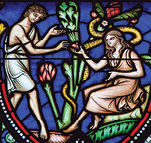Return to 1st Quarter 2018 articles.


When you mention Adam and Eve in a crowd of mixed beliefs about religion, what kind of a reaction do you get? I suggest the reactions are different from what they were 25 years ago. For some, it is an eye roll and perhaps a suggestion that they no longer believe in myths and fairy tales. For many, Adam and Eve are mythical figures of ancient Hebrew poetry — a story to teach, but certainly not history. Others suggest that the story of Adam and Eve is a social myth describing in figurative terms a view of human social evolution. For still others, the story is a description of a miraculous literal historical event of a few thousand years ago. Others simply do not have an opinion, and they do not care.
Throughout human history, these views have shaped the way people live on this planet. Some justified slavery because they felt their race was created by God while other races evolved. Those who view Adam and Eve as fictitious characters and the entire  account of them as allegorical at best open the door to compromising all of the biblical account. If Adam and Eve are symbols and never lived, then why could we not also say that Jesus Christ was a symbol and never lived? Our view of Adam and Eve has a domino effect. If you take the account as historical, then you have the question of where Cain got his wife? Did Adam have a belly button? What is a “help meet” and does this not justify the subjugation of women? Does “subdue” mean to exploit the Earth with no regard for pollution or depletion of resources? Some of these questions may never have completely satisfying answers, but most of them can be studied to find reasonable answers. We would like to attempt to do that in this article.
account of them as allegorical at best open the door to compromising all of the biblical account. If Adam and Eve are symbols and never lived, then why could we not also say that Jesus Christ was a symbol and never lived? Our view of Adam and Eve has a domino effect. If you take the account as historical, then you have the question of where Cain got his wife? Did Adam have a belly button? What is a “help meet” and does this not justify the subjugation of women? Does “subdue” mean to exploit the Earth with no regard for pollution or depletion of resources? Some of these questions may never have completely satisfying answers, but most of them can be studied to find reasonable answers. We would like to attempt to do that in this article.
The name Adam, in addition to being a proper name, also has the connotation of mankind and it occurs over 500 times in the Old Testament. In the New Testament, the name Adam occurs eight times — seven times referring to the first man (see Luke 3:38; Romans 5:14; 1 Corinthians 15:22, 45; 1 Timothy 2:13, 14; and Jude 1:14.) In 1 Corinthians 15:45 it is used as a reference to Christ. We would like to make three points about Adam as he is presented in the Bible.
1. ADAM WAS A CREATION:
UNIQUE AND DIFFERENT FROM ANYTHING ELSE.
There are three verses in Genesis 1 in which the word “create” (bara in Hebrew) refers to something only God can do — a miracle. In Genesis 1:1 bara is used to describe the creation of time, space, and matter/energy. In Genesis 1:21 it is used in reference to life. In Genesis 1:27 it refers to the creation of man and woman, “So God created mankind in his own image, in the image of God he created them, male and female he created them.” In Genesis 2:7 we read, “Then the LORD God formed a man from the dust of the ground … .” The Hebrew word used there is yatsar which means to form or fashion as a potter would fashion a vase. God makes a vessel into which he could place the man whom he created. The verse goes on to tell us that into the body he formed, God breathed the breath of life and the man became a living soul.
Adam was a miracle. The Bible does not tell us how God molded the ground to make the body, but the fullness of a human cannot be realized until there is a body to put the soul into and until that body has the breath of life and until the soul becomes the dominant part. James 1:13 tells us that God is incapable of deception. We can be sure that Adam did not have a belly button because that would be deceptive. We do not know what he looked like physically, but both he and Eve were created in God’s image spiritually, and that made them different from anything else in the creation. Genesis goes on to describe Adam’s existence. He lived as a gatherer, simply picking his food off the many trees in the garden. Genesis 2:15 tells us that Adam’s employment was to “work” and “take care of” the garden. The Hebrew word abad used in this verse is commonly used to describe labor. Exodus 20:9 uses the same word to describe human responsibility in the Ten Commandments. We were never intended to be idle.
There is every indication that Adam and Eve had children in the garden. In Genesis 1:28 they were commanded to “be fruitful and increase.” In Genesis 3:16 God told Eve, “I will make your pains in childbearing very severe; … .” That indicates she must have  had childbirth before. Those who have viewed sex as a punishment have a sad understanding of one of God’s most beautiful gifts to us. Sex is not evil, even though our generation has demeaned it. Genesis 3:16 is most accurately translated “your desire will be for your husband.” Genesis 2:24 explains that the man’s relationship with his wife is one of clinging, closure, and oneness in all the couple does. Being one involves far more than sexual intercourse. This means that a population left the Garden of Eden, not just one man and one woman. Cain married a distant relative born in the Garden, and incest was not an issue because no time for significant genetic damage had transpired. In Genesis 4:14 Cain was worried about other humans killing him because there was a population that came out of the garden. In Genesis 4:17 Cain builds a city, which means there was a population present to dwell within the city.
had childbirth before. Those who have viewed sex as a punishment have a sad understanding of one of God’s most beautiful gifts to us. Sex is not evil, even though our generation has demeaned it. Genesis 3:16 is most accurately translated “your desire will be for your husband.” Genesis 2:24 explains that the man’s relationship with his wife is one of clinging, closure, and oneness in all the couple does. Being one involves far more than sexual intercourse. This means that a population left the Garden of Eden, not just one man and one woman. Cain married a distant relative born in the Garden, and incest was not an issue because no time for significant genetic damage had transpired. In Genesis 4:14 Cain was worried about other humans killing him because there was a population that came out of the garden. In Genesis 4:17 Cain builds a city, which means there was a population present to dwell within the city.
Adam was very different from us. His communication with God was different, and in all probability his communication with the animals was different. He was now a farmer, not a gatherer. Animal husbandry was beginning as indicated by Abel being a herder.
2. THE FALL WAS PRIMARILY A SPIRITUAL EVENT
NOT PRIMARILY A PHYSICAL EVENT.
Genesis 2:17 tells us the word of God given to Adam and Eve about the forbidden fruit: “… you must not eat from the tree of the knowledge of good and evil, for when you eat from it you will certainly die.” They did not drop dead physically when they ate from the tree. Genesis 3:6 tells us that the physical appearance of the tree was that its fruit was good to eat. The next verse tells us that their eyes were opened. They obviously were not physically blind before eating from the tree. God also states that there was a “tree of life” (Genesis 3:22), and that its fruit would enable one to live forever. The Bible does not describe that tree, but Revelation 22:2 tells us that the tree of life will grow along the river flowing from the throne of God and of the Lamb in heaven. The image is clear that it is not a physical existence we will have in heaven. Our bodies are dust-to-dust, and 1 Corinthians 15:42-55 describes our new existence.

Adam and Eve did not drop dead physically when they ate the forbidden fruit, but they did drop dead spiritually. Paul in 1 Corinthians 15:44-50 tells us about Adam coming as a physical being, but being a place for the spirit to dwell. “It is sown a natural body; it is raised a spiritual body. If there is a natural body, there is also a spiritual body. So it is written: ‘The first man Adam became a living being’ [Greek psuche, meaning a breathing animal soul]; the last Adam [Jesus], a life-giving spirit [Greek pneuma, meaning a spiritual being]. The spiritual did not come first, but the natural, and after that the spiritual [came into being]. The first man [Adam] was of the dust of the earth; the second man is of heaven. … as we have borne the image of the earthly man [having a physical body], so shall we bear the image of the heavenly man [Jesus]. … flesh and blood cannot inherit the kingdom of God … .”
Attempting to make the fall a physical occurrence, and to say that the death referred to physical death misses the point of what happened when Adam and Eve disobeyed God. Humans were doomed to eternal separation from God and from all God had to offer us.
3. SINCE THE FALL GOD
HAS SOUGHT TO RESTORE US.
From Adam to Moses humans were in a free-fall having only instinctive morality. Romans 2:14-15 speaks of Gentiles doing instinctively some of what the Jews had in the law. Judges 17:6 and 21:25 tell us, “In those days Israel had no king; everyone did as they saw fit.” Cut off from God; humans were in chaos in the days of ancient Israel, in Paul’s day, and even today.
From Moses to Christ social order and structure came through legalism — a method that primitive humans could understand and live by. All connections to God were by force. God’s desire was and is to put us back into the relationship that Adam had with God. The way to do that was through Jesus Christ who gives us a way to live eternally. We are freed from legalism and given a relationship with God that is based on love, not force. Colossians 2:12-15 says it well: “having been buried with him in baptism, in which you were also raised with him through your faith in the working of God, who raised him from the dead. When you were  dead in your sins and in the uncircumcision of your flesh, God made you alive with Christ. He forgave us all our sins, having canceled the charge of our legal indebtedness, which stood against us and condemned us; he has taken it away, nailing it to the cross. And having disarmed the powers and authorities, he made a public spectacle of them, triumphing over them by the cross.”
dead in your sins and in the uncircumcision of your flesh, God made you alive with Christ. He forgave us all our sins, having canceled the charge of our legal indebtedness, which stood against us and condemned us; he has taken it away, nailing it to the cross. And having disarmed the powers and authorities, he made a public spectacle of them, triumphing over them by the cross.”
The message of Adam is a message of salvation — of being restored to God. In A.D. 70 the Temple was destroyed, wiping out all vestiges of the Old Law. All attempts of humans to follow a legalistic way of being restored to God were gone. The entire book of Galatians is devoted to Paul trying to stop the churches in Galatia from going back to the legalistic attempts to reach God by following laws. Jesus Christ gives us freedom from those legalistic attempts and brings those who obey him into a relationship with God. Revelation 21 and 22 gives a picture of that restored relationship. It is the beautiful relationship that Adam had in the beginning before sin separated us from God and made spiritual death a reality.
Picture credits:
© Jorisvo. Image from BigStockPhoto.com
© enterlinedesign. Image from BigStockPhoto.com
© enterlinedesign. Image from BigStockPhoto.com
© Jorisvo. Image from BigStockPhoto.com.
© artitcom. Image from BigStockPhoto.com
Scripture links/references are from BibleGateway.com.
